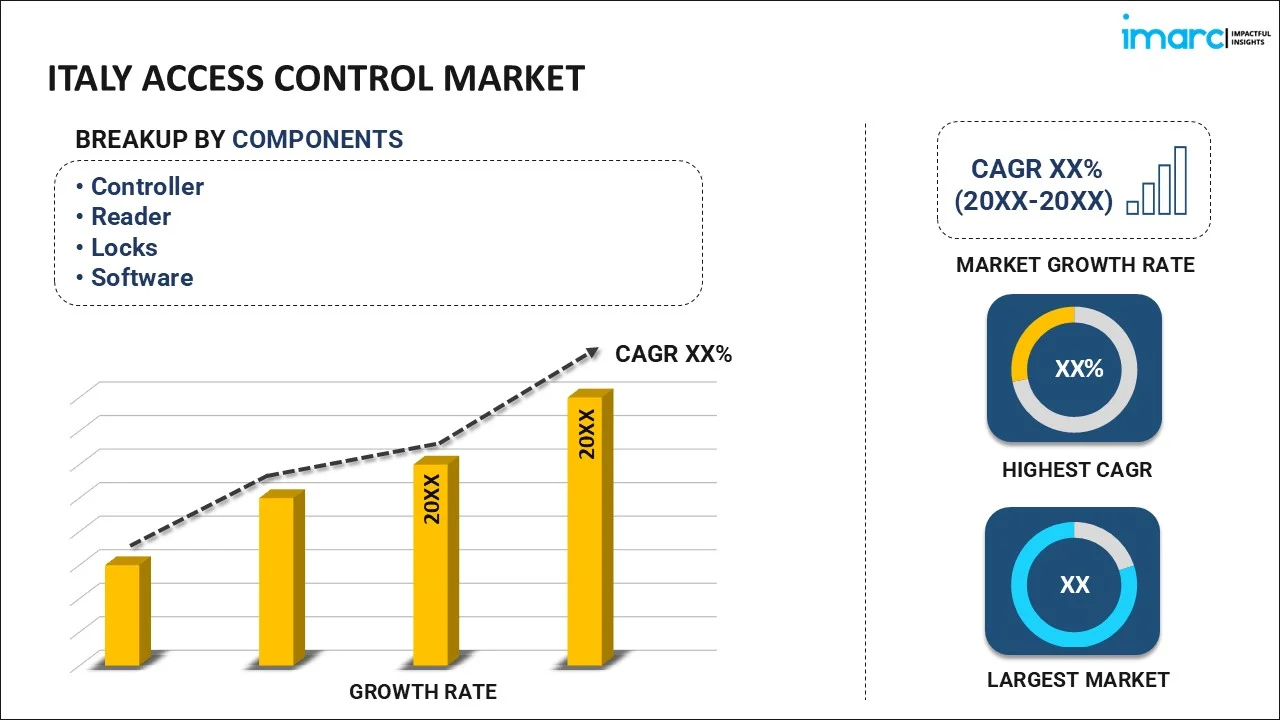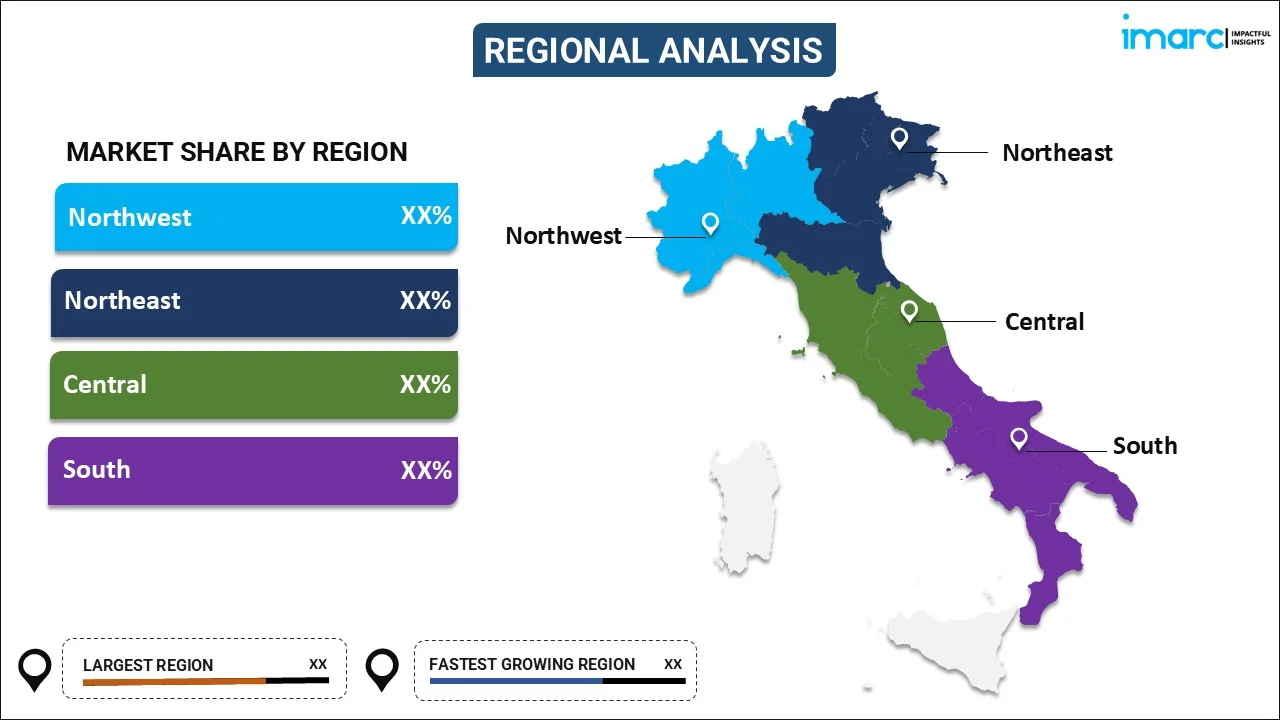
Italy Access Control Market Size, Share, Trends and Forecast by Component, Type, End User, and Region, 2025-2033
Italy Access Control Market Size and Share:
The Italy access control market size reached USD 233.20 Billion in 2024. Looking forward, IMARC Group expects the market to reach USD 462.28 Billion by 2033, exhibiting a growth rate (CAGR) of 7.32% during 2025-2033. The market is growing due to rising security concerns in the country, implementation of strict government regulations, widespread adoption of cloud-based solutions, rapid technological advancements, and the ongoing integration of the Internet of Things (IoT).
|
Report Attribute
|
Key Statistics
|
|---|---|
|
Base Year
|
2024
|
|
Forecast Years
|
2025-2033
|
|
Historical Years
|
2019-2024
|
| Market Size in 2024 | USD 233.20 Billion |
| Market Forecast in 2033 | USD 462.28 Billion |
| Market Growth Rate (2025-2033) | 7.32% |
Italy Access Control Market Trends:
Rising Security Concerns
Growing security concerns are fueling immense growth in Italy's access control market, most notably in industries handling confidential data, like finance, health care, and the government. Moreover, the heightened risk of theft, intrusions, and data leakage is compelling firms to implement cutting-edge security solutions for safeguarding both physical and data assets. For instance, Italian healthcare providers and banks are increasingly adopting biometric systems and RFID-based solutions to make data secure and prevent unauthorized access. This is even the case in homes, where spiking burglaries have promoted an upsurge in the use of smart locks. Furthermore, these facilities provide remote access, keyless entry, and real-time monitoring, offering a further layer of security for homeowners. As physical and cyber threats escalate, Italian organizations are focusing on advanced, multi-layered access control systems to protect assets, maintain regulatory compliance, and reduce security threats across industries.
Government Regulations
Secure safety regulations are implemented by the Italian government, which plays an important role in developing the access control market. In addition, the protection of data has gained higher importance because of regulatory guidelines such as the European Union's General Data Protection Regulation (GDPR). Consequently, companies need to install secure access control systems in order to restrict unauthorized access to sensitive information. Apart from the protection of data, government policies regarding the physical security of facilities in sectors such as energy, transport, and the health sector also call for the implementation of sophisticated access control systems. Furthermore, public organizations, government offices, and police forces across Italy have been progressively implementing hi-tech access control solutions to protect their people and assets.
Adoption of Cloud-Based Solutions
Cloud-based access control systems have become a significant growth catalyst in Italy's access control market, offering flexibility, scalability, and cost-effectiveness. In line with this, cloud-based solutions are replacing the traditional, on-premise access control systems with remote management and real-time monitoring capabilities. Further, this trend is especially helpful for multi-site businesses, as it does away with the requirement for expensive, localized IT infrastructure. Organizations are now able to manage access to multiple sites via a centralized, cloud-based system, which is less costly to maintain and more efficient in operation. In addition, cloud solutions provide the option to integrate with other systems like video surveillance, fire alarms, and attendance systems for employees, building a complete security infrastructure.
Italy Access Control Market Segmentation:
IMARC Group provides an analysis of the key trends in each segment of the market, along with forecasts at the region/country level for 2025-2033. Our report has categorized the market based on component, type, and end user.
Component Insights:

- Controller
- Reader
- Locks
- Software
The report has provided a detailed breakup and analysis of the market based on the component. This includes controller, reader, locks, and software.
Type Insights:
- Card-based
- Contact
- Contactless
- Biometric-based
- Fingerprint
- Face Recognition
- Face Recognition and Fingerprint
- Iris Recognition
- Others
The report has provided a detailed breakup and analysis of the market based on the type. This includes card-based (contact and contactless) and biometric-based (fingerprint, face recognition, face recognition and fingerprint, iris recognition, and others).
End User Insights:
- Government
- Military and Defense
- Commercial
- Healthcare
- Manufacturing
- Transport
- Education
- Residential
- Others
The report has provided a detailed breakup and analysis of the market based on the end user. This includes government, military and defense, commercial, healthcare, manufacturing, transport, education, residential, and others.
Region Insights:

- Northwest
- Northeast
- Central
- South
The report has also provided a comprehensive analysis of all the major regional markets, which include Northwest, Northeast, Central, and South.
Competitive Landscape:
The market research report has also provided a comprehensive analysis of the competitive landscape. Competitive analysis such as market structure, key player positioning, top winning strategies, competitive dashboard, and company evaluation quadrant has been covered in the report. Also, detailed profiles of all major companies have been provided.
Italy Access Control Market News:
- November 2024: ASSA ABLOY acquired IXLA, a leading Italian manufacturer of laser and color personalization systems for cards and passports. This acquisition strengthens ASSA ABLOY's position in Italy's access control market, particularly in government and financial sectors, enhancing security and document personalization solutions.
- In May 2024, Zwipe, a leader in the development of biometric technology on cards, entered into an agreement with Ermes srl to distribute biometric access cards in Italy.
- In October 2023, Sintesi signed a partnership with Zwipe to offer biometric cards for physical and logical access control in Italy.
Italy Access Control Market Report Coverage:
| Report Features | Details |
|---|---|
| Base Year of the Analysis | 2024 |
| Historical Period | 2019-2024 |
| Forecast Period | 2025-2033 |
| Units | Billion USD |
| Scope of the Report |
Exploration of Historical Trends and Market Outlook, Industry Catalysts and Challenges, Segment-Wise Historical and Future Market Assessment:
|
| Components Covered | Controller, Reader, Locks, Software |
| Types Covered |
|
| End Users Covered | Government, Military and Defense, Commercial, Healthcare, Manufacturing, Transport, Education, Residential, Others |
| Regions Covered | Northwest, Northeast, Central, South |
| Customization Scope | 10% Free Customization |
| Post-Sale Analyst Support | 10-12 Weeks |
| Delivery Format | PDF and Excel through Email (We can also provide the editable version of the report in PPT/Word format on special request) |
Key Questions Answered in This Report:
- How has the Italy access control market performed so far and how will it perform in the coming years?
- What is the breakup of the Italy access control market on the basis of component?
- What is the breakup of the Italy access control market on the basis of type?
- What is the breakup of the Italy access control market on the basis of end user?
- What are the various stages in the value chain of the Italy access control market?
- What are the key driving factors and challenges in the Italy access control market?
- What is the structure of the Italy access control market and who are the key players?
- What is the degree of competition in the Italy access control market?
Key Benefits for Stakeholders:
- IMARC’s industry report offers a comprehensive quantitative analysis of various market segments, historical and current market trends, market forecasts, and dynamics of the Italy access control market from 2019-2033.
- The research report provides the latest information on the market drivers, challenges, and opportunities in the Italy access control market.
- Porter's five forces analysis assist stakeholders in assessing the impact of new entrants, competitive rivalry, supplier power, buyer power, and the threat of substitution. It helps stakeholders to analyze the level of competition within the Italy access control industry and its attractiveness.
- Competitive landscape allows stakeholders to understand their competitive environment and provides an insight into the current positions of key players in the market.
Need more help?
- Speak to our experienced analysts for insights on the current market scenarios.
- Include additional segments and countries to customize the report as per your requirement.
- Gain an unparalleled competitive advantage in your domain by understanding how to utilize the report and positively impacting your operations and revenue.
- For further assistance, please connect with our analysts.
 Request Customization
Request Customization
 Speak to an Analyst
Speak to an Analyst
 Request Brochure
Request Brochure
 Inquire Before Buying
Inquire Before Buying




.webp)




.webp)












